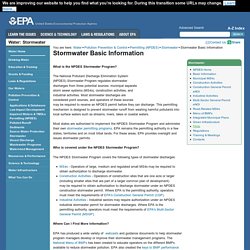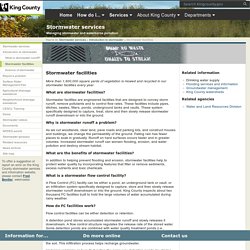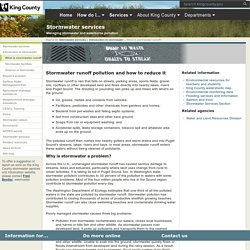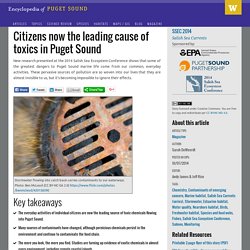

EPA Stormwater Program. What is the NPDES Stormwater Program?

The National Pollutant Discharge Elimination System (NPDES) Stormwater Program regulates stormwater discharges from three potential sources: municipal separate storm sewer systems (MS4s), construction activities, and industrial activities. Most stormwater discharges are considered point sources, and operators of these sources may be required to receive an NPDES permit before they can discharge. This permitting mechanism is designed to prevent stormwater runoff from washing harmful pollutants into local surface waters such as streams, rivers, lakes or coastal waters. Most states are authorized to implement the NPDES Stormwater Program and administer their own stormwater permitting programs. EPA remains the permitting authority in a few states, territories and on most tribal lands. Who is covered under the NPDES Stormwater Program? The NPDES Stormwater Program covers the following types of stormwater discharges: Where Can I Find More Information?
Ecology Brochure Overview. About Stormwater Facilities. More than 1,600,000 square yards of vegetation is mowed and recycled in our stormwater facilities every year.

What are stormwater facilities? Stormwater facilities are engineered facilities that are designed to convey storm runoff, remove pollutants and to control flow rates. About Stormwater in King County. Stormwater runoff is rain that falls on streets, parking areas, sports fields, gravel lots, rooftops or other developed land and flows directly into nearby lakes, rivers and Puget Sound.

The drizzling or pounding rain picks up and mixes with what's on the ground: Oil, grease, metals and coolants from vehicles; Fertilizers, pesticides and other chemicals from gardens and homes; Bacteria from pet wastes and failing septic systems; Soil from construction sites and other bare ground; Soaps from car or equipment washing; and Accidental spills, leaky storage containers, tobacco spit and whatever else ends up on the ground. The polluted runoff then rushes into nearby gutters and storm drains and into Puget Sound's streams, lakes, rivers and bays. In most areas, stormwater runoff enters these waters without being cleaned of pollutants.
Why is stormwater a problem? Poorly managed stormwater causes three big problems: Start with doing one of the actions on the following top 10 list: Pollution: Citizens Now Leading Cause of Toxics in Puget Sound. Key takeaways On tiny Mandarte Island in British Columbia, a group of biologists gathers for a pre-dawn raid on a population of double-crested cormorants.

They will flush the birds from their nests just long enough to collect a sampling of eggs that they will take back to the lab for testing. But in this case, they are not studying the birds as much as they are documenting human behavior. The scientists are tracking the chemical signatures of modern civilization. Loving the Puget Sound to Death. This article was reported with support from the National Health Journalism Fellowship, a program of the USC Annenberg School for Communication and Journalism.

Hidden amid the pleasure boats and cargo ships that roar through the canal in northwest Seattle is one of the oldest fishing economies in North America. From midsummer to October, from early morning until after dusk, fishermen from the Suquamish Tribe zoom up and down the canal in orange waterproof overalls, tending to salmon nets that dangle across the water like strings of pearls. The tribe holds reservation land about ten miles west of the city, on the far side of Puget Sound, the 100-mile-long estuary that extends from Olympia, Washington, north to the Strait of Juan de Fuca. The Suquamish are one of more than a dozen tribes that have fishing and shellfish-harvesting rights all across this region, and their fishing traditions, which are thousands of years old, predate all of the oldest shipyard industries here. How We Got Here. SEATTLE — Gliding through the clear, emerald water of Puget Sound, Diver Laura James stopped when something shiny on the bottom caught her eye.

She reached down and picked up a tire-flattened beer can. And then she noticed more garbage — stir straws, bubble gum wrappers, coffee lids, a plastic packet of ketchup — littered across the sound’s sandy floor. “I didn’t understand what I was seeing at first,” James says. “We’d swim along and we’d see this decaying swath – black with dead leaves and garbage. Curbing Stormwater Pollution. All You Need to Know About Stormwater Runoff.